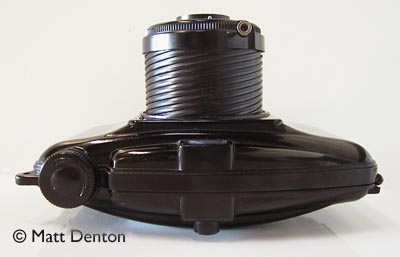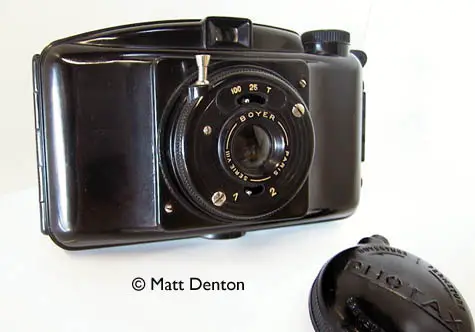- Produced 1938-1946 M.I.O.M., Vitry-sur-Seine, France
- Film type 620 rollfilm
- Picture size 6×9
- Weight 13oz (369g)
- Lens Boyer Paris Série VIII
- Focal range 2.75m to infinity
- Shutter simple spring (self-cocking)
- Shutter speeds 1/100, 1/25, T
- Viewfinder simple Gallilean viewfinder
- red window counter
Overview
Ooh-la-la! I had never heard of this sexy french beauty until my friend Ken Smith bought one and sent me such beautiful pictures of his that I immediately got that ‘must have it’ urge, and even my wife who saw it over my shoulder said, ‘wow, why don’t you get one of those?’ So, needless to say, I had to. I’m glad I did! To hold it is to fall in love, it’s so smooth and well-balanced. You pick it up and suddenly hear yourself whisper ‘Oh, mon petit cherie…’
MIOM (Manufacture d’Isolants et d’Objets Moulés) was a plastics company located in Vitry-sur-Seine, France, way back in the day. Apparently a growing opportunity for paid holidays for the working class in France around 1937 caused MIOM to diversify and begin making cameras in addition to electrical insulators and other objets moulés. One of their first was the the curvaceous, organic Photax Blindé (‘armored Photax’) which became their flagship camera. Not too complicated, it has two shutter speeds and two apertures, and takes eight 6x9cm pictures on 620 film with its surprisingly sharp single-element Boyer-Paris Série VIII lens. They obviously had the right idea — this camera was popular enough to spawn both a long line of Photaxes and many imitators. Fit, Fotex, Pionyr, Carlton, to name a few.
There were two versions of Photax before this one, which the manual actually calls a Photax III V but is commonly referred to as the Photax Blindé (‘armored Photax’), after its unique protective cap. The oversized cap actually fits over the front of the lens mount and up over the shutter release to prevent accidental tripping of the shutter when not in use. I was lucky enough to get one with both the lens cap and fitted leather case. Not to mention a 40-year-old roll of unexposed french Kodak color film!
Technically not a rangefinder, and certainly not a compact, I put this in with the box cameras as it’s functionally right in with the Clack and Duex as a minor evolution from a traditional square box camera. Simple spring shutter, sliding aperture disc, simple viewfinder, meniscus lens. Curved film plane like the later Clack et al to help control image aberration. Here the lens and shutter are mounted in a tube that screws out of the body and gently but firmly locks in place. The shutter release sticks straight up from the lens mount and accepts a shutter release.

These days a camera like this falls into the ‘toy camera’ category along with any plastic camera with limited controls — Holga, Diana et al. When you have computerized cameras that do everything but push the button for you I can see how this can be called a toy in comparison. Yet they continue to be desirable because of a factor that is missing from auto-everything machines: the fun factor. There’s an element of chance, of surprise, of humanity and history when using a camera like this that is utterly charming in a way that a Cosina-made Nikon with a Quantaray zoom never will be.
Controls on the Photax are indeed limited: your shutter speed choices are a questionable 1/100 and 1/25, and so even with the addition of two aperture choices this is essentially just a daylight snapshot camera for taking pictures of your picnic along the Seine, its bakelite armor resistant to spilled wine (rolls right off!) and cheesy fingerprints (wipes right off!).
My peek at a scan of the manual confirmed my original hunch – the small aperture (2) is for sunny days, large (1) is for cloudy days, and 1/25, originally ‘normal’ speed for slow film, would work for for indoor or low-light shots. Also note that the T setting is really more like a B setting, it’s not ‘click and click again’ it’s ‘click and hold’. At least on my example.
In terms of film, if you can find ASA 50 that is about perfect — it’s the speed the manual recommmends (aka DIN 18) — but 125 is just fine. 400 is too fast. Even on a cloudy day my Tri-X negs were overexposed. Sadly, the venerable Verichrome Pan is now discontinued but Plus-X is great stuff. Agfapan APX 100 is good too. Of course, 620 means you need to respool 120 film onto the smaller 620 spools, which though relatively simple, is more trouble than most people think it’s worth. Trust me, it’s trivial once you get the hang of it. I can do it in about 5 minutes. When you do respool (see links below), don’t forget to ask for the 620 spool back when you drop off your film.
Speaking of filters, there was apparently an accessory closeup lens for this camera that allowed focusing down to 1m (instead of 2+m). Looks like it might accept a 27mm slip-on lens or adapter. Barring that, you could probably bluetack a filter to the front if that’s your thing.
PS T’was a fine and friendly french fellow Frank who sent me scans of the original manual when I inquired nicely, his fantastic website of french cameras is here. I think he’s interested in selling part of his collection, you may want to contact him!
Repairs
I started to clean it with Flitz metal and fiberglass cleaner, but that wasn’t giving it the shine I was looking for so I switched to Windex and that made it pretty. It does have a small crack in the back door that *shouldn’t* leak light but I’ll have to go easy on the thing or risk having to get out the epoxy, model glue, or whatever it is you fix bakelite with.
Tips & Tricks
The back opens with a sliding lock on the side, not spring-loaded like most I’ve seen, just slide down to unlock and when you close the back slide it back up. Put your film on the right and an empty 620 spool on the left where the wind knob is, close the back and wind on till you see the number 1 in the red window. Expose a frame and wind on till you see 2, etc. Try not to let the sun shine on the red window. By the way there really aren’t any light seals in this camera, it just fits together like a black plastic puzzle and keeps light out around the corners by virtue of the way it fits together.
Speaking of puzzle pieces, there are – or are supposed to be – two little inserts for the film rails, I’m missing mine, which results in ‘wings’ on my negs. Keep an eye out for these if you plan to use the camera as a user. I’m working on a suitable fix for missing rail pieces. I’m thinking maybe balsa wood from a toy glider? Stay tuned.
Other notes, the viewfinder is a little small but I think that’s part of this gem’s quirky charm. And since it is so smooth and nice to hold, I recommend a little wrist strap for it in its single strap lug. With the leather case it’s better protected but nowhere near as fun! And if you’re going to put it on a tripod you’ll need an adapter, the Photax has a 3/8″ tripod thread. They sell them here.
Related Links
- The Foto Fex Camera Collection has this and similar bakelite cameras
- The Classic Camera blog has one too
- Another very nice site with a comprehensive Photax timeline (and for many other french cameras!)
- Excellent fully illustrated tutorial for respooling 120 film
